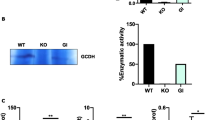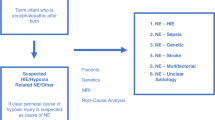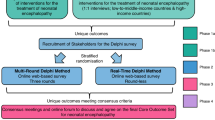Abstract
Glutaryl-CoA dehydrogenase (GCDH) deficiency is a rare neurometabolic disorder that is considered treatable if patients are identified before the onset of acute encephalopathic crises. To allow early identification of affected individuals, tandem mass spectrometry-based newborn screening for GCDH deficiency has been started in Germany in 1999. We prospectively followed neonatally screened patients (n = 38) and compared the neurologic outcome with patients from a historical cohort (n = 62). In the majority of neonatally screened children, the onset of encephalopathic crises has been prevented (89%), whereas acute encephalopathic crises or progressive neurologic impairment was common in the historical cohort. Neonatal screening in combination with intensive management is effective – even assuming ascertainment bias in the historical cohort. Similar proportions of commonest mutations and biochemical phenotypes (high and low excretors) were found in neonatally screened and historical patients. However, potential predictor variables for mild clinical phenotypes are not yet known and thus a selection of these patients by newborn screening is not excluded. No patient was known to be missed by newborn screening from 1999 to 2005. In conclusion, this study confirms that newborn screening for GCDH deficiency in combination with intensive management is beneficial.
Similar content being viewed by others
Log in or create a free account to read this content
Gain free access to this article, as well as selected content from this journal and more on nature.com
or
Abbreviations
- 3-OH-GA:
-
3-hydroxyglutaric acid
- C5DC:
-
glutarylcarnitine
- GA:
-
glutaric acid
- GCDH:
-
glutaryl-CoA dehydrogenase (EC 1.3.99.7)
- GC/MS:
-
gas chromatography/mass spectrometry
- MS/MS:
-
tandem mass spectrometry
- NBS:
-
newborn screening
References
Goodman SI, Markey SP, Moe PG, Miles BS, Teng CC 1975 Glutaric aciduria: a “new” disorder of amino acid metabolism. Biochem Med 12: 12–21
Lindner M, Köolker S, Schulze A, Christensen E, Greenberg CR, Hoffmann GF 2004 Neonatal screening for glutaryl-CoA dehydrogenase deficiency. J Inherit Metab Dis 27: 851–859
Greenberg CR, Prasad AN, Dilling LA, Thompson JR, Haworth JC, Martin B, Wood-Steinman P, Seargeant LE, Seifert B, Booth FA, Prasad C 2002 Outcome of the first 3-years of a DNA-based neonatal screening program for glutaric acidemia type 1 in Manitoba and northwestern Ontario, Canada. Mol Genet Metab 75: 70–78
Strauss KA, Puffenberger EG, Robinson DL, Morton DH 2003 Type I glutaric aciduria, part 1: natural history of 77 patients. Am J Med Genet C Semin Med Genet 121: 38–52
Goodman SI, Stein DE, Schlesinger S, Christensen E, Schwartz M, Greenberg CR, Elpeleg ON 1998 Glutaryl-CoA dehydrogenase mutations in glutaric acidemia (type I): review and report of thirty novel mutations. Hum Mutat 12: 141–144
Zschocke J, Quak E, Guldberg P, Hoffmann GF 2000 Mutation analysis in glutaric aciduria type I. J Med Genet 37: 177–181
Christensen E 1983 Improved assay of glutaryl-CoA dehydrogenase in cultured cells and liver: application to glutaric aciduria type I. Clin Chim Acta 129: 91–97
Hoffmann GF, Athanassopoulos S, Burlina AB, Duran M, de Klerck JB, Lehnert W, Leonard JV, Monavari AA, Müller E, Muntau AC, Naughten ER, Plecko-Starting B, Superti-Furga A, Zschocke J, Christensen E 1996 Clinical course, early diagnosis, treatment, and prevention of disease in glutaryl-CoA dehydrogenase deficiency. Neuropediatrics 27: 115–123
Bjugstad KB, Goodman SI, Freed CR 2000 Age at symptom onset predicts severity of motor impairment and clinical outcome of glutaric acidemia type 1. J Pediatr 137: 681–686
Kyllerman M, Skjeldal O, Christensen E, Hagberg G, Holme E, Lonnquist T, Skov L, Rotwelt T, von Dobeln U 2004 Long-term follow-up, neurological outcome and survival rate in 28 Nordic patients with glutaric aciduria type 1. Eur J Paediatr Neurol 8: 121–129
Kölker S, Garbade SF, Greenberg CR, Leonard JV, Saudubray JM, Ribes A, Kalkanoglu HS, Lund AM, Merinero B, Wajner M, Troncoso M, Williams M, Walter JH, Campistol J, Marti-Herrero M, Caswill M, Burlina AB, Lagler F, Maier EM, Schwahn B, Tokatli A, Dursun A, Coskun T, Chalmers RA, Koeller DM, Zschocke J, Christensen E, Burgard P, Hoffmann GF 2006 Natural history, outcome and therapeutic efficacy in children and adults with glutaryl-CoA dehydrogenase deficiency. Pediatr Res 59: 840–847
Külkens S, Harting I, Sauer S, Zschocke J, Hoffmann GF, Gruber S, Bodamer OA, Kölker S 2005 Late-onset neurologic disease in glutaryl-CoA dehydrogenase deficiency. Neurology 64: 2142–2144
Naughten ER, Mayne PD, Monavari AA, Goodman SI, Sulaiman G, Croke DT 2004 Glutaric aciduria type I: outcome in the Republic of Ireland. J Inherit Metab Dis 27: 917–920
Baric I, Wagner L, Feyh P, Liesert M, Buckel W, Hoffmann GF 1999 Sensitivity and specificity of free and total glutaric acid and 3-hydroxyglutaric measurements by stable-isotope dilution assays for the diagnosis of glutaric aciduria type I. J Inherit Metab Dis 22: 867–881
Schulze A, Lindner M, Kohlmuller D, Olgemoller K, Mayatepek E, Hoffmann GF 2003 Expanded newborn screening for inborn errors of metabolism by electrospray ionization-tandem mass spectrometry: results, outcome, and implications. Pediatrics 111: 1339–1406
Chace DH, Kalas TA, Naylor EW 2003 Use of tandem mass spectrometry for multianalyte screening of dried blood spot specimens from newborns. Clin Chem 49: 1797–1817
Wilcken B, Wiley V, Hammond J, Carpenter K 2003 Screening newborns for inborn errors of metabolism by tandem mass spectrometry. N Engl J Med 348: 2304–2312
Kölker S, Christensen E, Leonard JV, Greenberg CR, Burlina AB, Burlina AP, Dixon M, Duran M, Goodman SI, Koeller DM, Müller E, Naughten ER, Neumaier-Probst E, Okun JG, Kyllerman M, Surtees RA, Wilcken B, Hoffmann GF, Burgard P 2007 Guideline for the diagnosis and management of glutaryl-CoA dehydrogenase deficiency (glutaric aciduria type I). J Inherit Metab Dis 30: 5–22
Cole TJ 1990 The LMS method for constructing normalized growth standards. Eur J Clin Nutr 44: 45–60
Kromeyer-Hauschild K, Wabitsch M, Kunze D, Geller F, Geiβ HC, Hesse V, von Hippel A, Jaeger U, Johnsen D, Korte W, Menner K, Müller D, Müller JM, Niemann-Pilatus A, Remer T, Schaefer F, Wittchen HU, Zabransky S, Zellner K, Ziegler A, Hebebrand J 2001 [Percentiles for the Body measure index for the children and adolescents under consulting different German samples]. Monatsschr Kinderheilkd 149: 807–818
Prader A, Largo RH, Molinari L, Issler C 1989 Physical growth of Swiss children from birth to 20 years of age. First Zurich longitudinal study of growth and development. Helv Paediatr Acta Suppl 52: 1–125
Haworth JC, Dilling LA, Seargeant LE 1991 Increased prevalence of hereditary metabolic diseases among native Indians in Manitoba and northwestern Ontario. CMAJ 145: 123–129
Hoffmann GF, Trefz FK, Barth PG, Böhles JH, Biggemann B, Bremer HJ, Christensen E, Frosch M, Hanefeld F, Hunneman DH, Jacobi H, Kurlemann G, Lawrenz-Wolf B, Rating D, Roe CR, Schutgens RB, Ullrich K, Weisser J, Wendel U, Lehnert W 1991 Glutaryl-coenzyme A dehydrogenase deficiency: a distinct encephalopathy. Pediatrics 88: 1194–1203
Morton DH, Bennett MJ, Seargeant LE, Nichter CA, Kelley RI 1991 Glutaric aciduria type I: a common cause of episodic encephalopathy and spastic paralysis in the Amish of Lancaster County, Pennsylvania. Am J Med Genet 41: 89–95
R Development Core Team 2006 R: A language and environment for statistical computing. Vienna: R foundation for statistical computing. URL:http://www.R-project.org, accessed April 18, 2007
WHO Multicentre Growth Reference Study Group 2006 WHO Motor Development Study: windows of achievement for six gross motor developmental milestones. Acta Paediatr Suppl 450: 86–95
Gallagher RC, Cowan TM, Goodman SI, Enns GM 2005 Glutaryl-CoA dehydrogenase deficiency and newborn screening: retrospective analysis of a low excretor provide further evidence that some cases may be missed. Mol Genet Metab 86: 417–420
Lindner M, Ho S, Fang-Hoffmann J, Hoffmann GF, Kölker S 2006 Neonatal screening for glutaric aciduria type I: Strategies to proceed. J Inherit Metab Dis 29: 378–382
Andresen BS, Dobrowski SF, O'Reilly L, Muenzer J, McCandless SE, Frazier DM, Udvari S, Bross P, Knudsen I, Banas R, Chace DH, Engel P, Naylor EW, Gregersen N 2001 Medium-chain acyl-CoA dehydrogenase (MCAD) mutations identified by MS/MS-based screening of newborns differ from those observed in patients with clinical symptoms: identification and characterization of a new, prevalent mutation that results in mild MCAD deficiency. Am J Hum Genet 68: 1408–1418
Ensenauer R, Vockley J, Willard JM, Huey JC, Sass JO, Edland SD, Burton BK, Berry SA, Santer R, Grunert S, Koch HG, Marquardt I, Rinaldo P, Hahn S, Matern D 2004 A common mutation is associated with a mild, potentially asymptomatic phenotype in patients with isovaleric acidemia diagnosed by newborn screening. Am J Hum Genet 75: 1136–1142
Burgard P, Rupp A, Konecki DS, Trefz FK, Schmidt H, Lichter-Konecki U 1996 Phenylalanine hydroxylase genotypes, predicted residual enzyme activity and phenotypic parameters of diagnosis and treatment of phenylketonuria. Eur J Pediatr 155: S11–S15
Christensen E, Ribes A, Merinero B, Zschocke J 2004 Correlation of genotype and phenotype in glutaryl-CoA dehydrogenase deficiency. J Inherit Metab Dis 27: 861–868
Chace DH, DiPerna JC, Mitchell B, Sgroi B, Hofman LF, Naylor EW 2001 Electrospray tandem mass spectrometry for analysis of acylcarnitines in dried post-mortem blood specimens collected by autopsy from infants with unexplained cause of death. Clin Chem 47: 1166–1182
Acknowledgements
These authors are indebted for the patients and their families for their participation and trust, particularly the German parents group “Glutaric aciduria e.V.” (URL: www.glutarazidurie.de) which was instrumental for this study. We are grateful to B. Assmann, R. Brackmann, A. M. Das, F. Lagler, O. Hendricks, E. Mayatepek, T. Marquardt, A. Muntau, W. Röschinger, A. Schulze, B. Schwahn, K. Ullrich, and U. Wendel for reports on patients and fruitful discussions. We thank J. G. Okun, D. Kohlmüller, C.-D. Langhans, P. Feyh, and S. Exner-Camps for excellent technical support of organic acid analysis and acylcarnitine profiling, and E. Christensen (Copenhagen, Denmark) for GCDH enzyme analysis. We are grateful to K. Kromeyer-Hauschild for providing LMS values. We thank A. Schulze (president, Deutsche Gesellschaft für Neugeborenenscreening) for providing the numbers of screened newborns in Germany.
Author information
Authors and Affiliations
Corresponding author
Additional information
This study was supported by a grant from the German Federal Ministry of Education and Sciences (BMBF # 01GM0305) and a grant from the “Kindness for Kids” Foundation, Munich, Germany – both to S. K. and G. F. H.
Rights and permissions
About this article
Cite this article
Kölker, S., Garbade, S., Boy, N. et al. Decline of Acute Encephalopathic Crises in Children with Glutaryl-CoA Dehydrogenase Deficiency Identified by Newborn Screening in Germany. Pediatr Res 62, 357–363 (2007). https://doi.org/10.1203/PDR.0b013e318137a124
Received:
Accepted:
Issue date:
DOI: https://doi.org/10.1203/PDR.0b013e318137a124
This article is cited by
-
Biochemical and molecular features of chinese patients with glutaric acidemia type 1 from Fujian Province, southeastern China
Orphanet Journal of Rare Diseases (2023)
-
Evaluierung und Optimierung des Neugeborenenscreenings mittels strukturierter Langzeitbeobachtung – am Beispiel der angeborenen Stoffwechselerkrankungen
Bundesgesundheitsblatt - Gesundheitsforschung - Gesundheitsschutz (2023)
-
The biochemical subtype is a predictor for cognitive function in glutaric aciduria type 1: a national prospective follow-up study
Scientific Reports (2021)
-
Audiological and otologic manifestations of glutaric aciduria type I
Orphanet Journal of Rare Diseases (2020)
-
Neurological manifestations of organic acidurias
Nature Reviews Neurology (2019)



